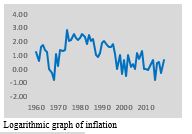The Effects of Balance of Trade and Economic Development Factors on The Exchange rate: Case of Morocco
Abstract
The relationship between accounts of trade balance and exchange rates has long been examined by previous studies, and the obtained results differ from one research to another depending on the methodology applied. This paper examines the various effects of Morocco’s balance of trade and other economic factors on the exchange rate of the Moroccan Dirham (MAD) with respect to the American Dollar (USD). An annual time series data was collected from 1960 to 2018 from the World Bank Data Group concerning exports, imports, gross domestic product (GDP), inflation, and the official exchange rate. Johansen co-integration test, vector autoregressive (VAR) model, Vector error corrective model (VECM), and Granger Causality were applied to test the significance and impact of variables related to the trade balance and economic factors. Results revealed a cointegration association between the variables. This association is exhibited on both the short-run and the long-run. Only inflation displayed an association with the exchange rate on the short run. On the other hand, exports, imports, and GDP appeared to be cointegrated with the exchange rate on the long run. Unlike the trade balance components, GDP and inflation appeared to Granger-cause the exchange rate of Morocco.
Downloads
References
Abbas, Q., Iqbal, J., & Ayaz (2012). Relationship between GDP, Inflation and Real Interest
Rate with Exchange Rate Fluctuation of African Countries. International Journal of
Academic Research in Accounting, Finance and Management Sciences, 2(3), 1-10.
Aggarwal, R. & Schirm, D. C. (1992). Balance of trade announcements and asset prices: Influence on equity prices, exchange rates, and interest rates. Journal of International Money and Finance, 11(1), 80-95.
Arize, A. C., Malindretos, J., & Igwe, E. U. (2017). Do Exchange Rate Changes Improve the Trade Balance: An Asymmetric Nonlinear Cointegration Approach. International Review of Economics and Finance, 49, 313-326.
Aziz, N. (2008). The Role of Exchange Rate in Trade Balance: Empirics from Bangladesh. Birmingham, UK: University of Birmingham.
Bahmani-Oskooee, M. and Saha, S. (2017). Asymmetric response of the US–India trade balance to exchange rate changes: Evidence from 68 industries. The World Economy, 40(10), 2226-2254.
Barthel, P. A. & Planel, S. (2010). Tanger-Med and Casa-Marina, Prestige Projects in Morocco: New Capitalist Frameworks and Local Context. Built Environment, 36(2), 176-191(16).
Bozdogan, H. (1987). Model selection and Akaike’s Information Criterion (AIC): The general theory and its analytical extensions. Psychometrika, 52(3), 345-370.
Currie, J. & Harrison, A. (1997). Sharing the Costs: The Impact of Trade Reform on Capital and Labor in Morocco. Journal of Labor Economics, 15(S3), S44-S71.
Dickey, D.A. and Fuller, W.A., (1981). Likelihood ratio statistics for autoregressive time series with a unit root. Econometrica, 49, 1057-1072.
Dornhbusch, R. & Fischer, S. (1980). Exchange Rates and the Current Account. American Economic Review, 70(5), 960-971.
Doukas, J. & Lifland, S. (1994). Exchange Rates and the Role of the Trade Balance Account. Managerial Finance, 20(5), 67-78.
El Imrani, O. & Babounia, A. (2016). Tangier Med Port: What role for the Moroccan Economy and the International Trade? International Journal of Research in Management, Economics and Commerce, 06(07), 73-81.
Ezzat, A. M. (2018). The effect of exchange rate movements on trade balance performance in Egypt: Is there a J-curve phenomenon? Scientific Journal for Economic& Commerce, 48(4), 659-692.
Granger, C. W. J., (1969). Investigating causal relations by econometric models and cross-spectral methods. Econometrica, 37(3), 424-438.
Granger, C. W. J., (1981). Some Properties of Time Series Data and their Use in Econometric Model Specification. Journal of Econometrics, 16, 121-130.
Hacker, R. S. and Hatemi-J, A. (2008). Optimal lag-length choice in stable and unstable VAR models under situations of homoscedasticity and ARCH. Journal of Applied Statistics, 35(6), 601–615.
Irwin, D. A. (1989). Trade Deficit Announcements, Intervention, and the Dollar. Economic Letters, 31(3), 257-262.
Jadoon, A. U. and Guang, Y. (2019). The Effect of Exchange Rate Fluctuations on Trade Balance of Pakistan. International Journal of Economic Sciences, 8(1), 68-80.
Johansen, S. (1991). Estimation and Hypothesis Testing of Cointegration Vectors in Gaussian Vector Autoregressive Models. Econometrica, 59(6), 1551-1580.
Kitamura, Y. (1998). Likelihood-Based Inference in Cointegrated Vector Autoregressive Models by Søren Johansen. Econometric Theory, 14(4), pp. 517-524.
Liew, K. S., Lim, K. P., & Hussain, H. (2003). Exchange Rate and Trade Balance Relationship: thethe Experience of Asean Countries. International Trade, 0307003.
Lim, Y. C. & Sek, S. K. (2015). An Examination on the Determinants of Inflation. Journal of Economics, Business and Management, 3(7), 1-5.
Mussa, M. (1982). A Model of Exchange Rate Dynamics. Journal of Political Economy, 90(1), 74-104.
Oluwapelumi, A. and Olaride, O. B., (2017). Granger Causality between Growth in the Education Sector and Social Economic Services in Nigeria. Equatorial Journal of Social Sciences and Human Behaviour, 2(1), 44-55.
Onafowora, O. (2003). Exchange rate and trade balance in East Asia: is there a J−curve? Economics Bulletin, 5(18), 1−13.
Sadok, H. (2018). The Effect of Exchange Rates on Trade Balance: An Empirical Study of Morocco. Journal of Business and Economics Review, 3(1), 1-10.
Vural, B. M. T. (2016). Effect of Real Exchange Rate on Trade Balance: Commodity Level Evidence from Turkish Bilateral Trade Data. Procedia Economics and Finance, 38, 499–507.
Yol, M. A. and Baharumshah, A. Z. (2005). The Effect of Exchange Rate Changes on Trade Balances in North Africa: Evidence. International Trade and Finance Association, 46.
Yusoff, M. B. (2007). The Malaysian Real Trade Balance and the Real Exchange Rate. International Review of Applied Economics, 21(5), 655–667.

Copyright (c) 2022 INTERNATIONAL JOURNAL OF ECONOMICS, BUSINESS AND HUMAN BEHAVIOUR

This work is licensed under a Creative Commons Attribution-NonCommercial 4.0 International License.











